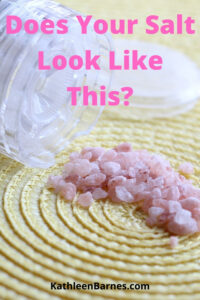 You’ve no doubt heard how “evil” salt is. How it raises your blood pressure and over-consumption is the root of many health problems, right?
You’ve no doubt heard how “evil” salt is. How it raises your blood pressure and over-consumption is the root of many health problems, right?
How about if I told you the problem is not in eating salt, but in the kind of salt you’re eating? How about if I told you that most of us need more salt, especially those with high blood pressure? Would you say I’m crazy?
Truly, I’m not. The salt myth is another of the nutrient lies that have been adopted by the medical profession with no basis in science or fact.
The problem started in the early 20th century when some food industry genius decided that our lovely pink and gray salt was not pretty enough. So they took out all the minerals except sodium and chloride and made this nice pretty white salt.
You see, unrefined sea salt contains a wealth of minerals, in fact all of the dozens of trace minerals needed for perfect human health, all in the correct proportions. But it had that pinkish or grayish color with visible dark flecks of minerals in it.
Thinking, as they always do, these food industry geniuses decided that they knew better than Mother Nature.
So they created this pretty pristine white salt.
After a few years, they noticed an epidemic of goiters and mental retardation, both severe signs of iodine deficiency.
“Oops!” they said and added some iodide back in. So the new salt was sodium, chloride and iodide. (Never mind that chloride negates the body’s ability to absorb the iodine. That’s a subject for another day.)
It was still pretty and snow white. This table salt has the nutritional equivalent of white bread. That means it has no nutritional value and because it unbalances minerals, it is actually harmful.
Salt is not only healthy, it is crucial to our survival. But it must be the right salt: unrefined sea salt.
How can you tell what’s the good stuff?
It’s easy: If it’s white, it’s not good. Unrefined sea salt has visible flecks of minerals. It is often pink in color or sometimes gray, another sign of its mineral wealth. Sea salt has all the ionic minerals and trace minerals in the perfect balance we need for good health.
Even those so-called “sea salts” available in your supermarket are nutritionally void. They’re still white, unless the packaging specifically says they are unrefined.
Dr. Robert Thompson, my co-author on The Calcium Lie: What Your Doctor Still Doesn’t Know, says that most of us need 3 grams of salt or salt-derived ionic minerals a day, just to keep ahead of our bodies’ needs.
This is contrary to the advice of most physicians, who recommend sodium restriction. High blood pressure, also known as hypertension, is a mineral deficiency disease. You’ll probably be surprised that the disease is actually caused by sodium deficiency and calcium excess. Testing intracellular levels of sodium and calcium will confirm this.
Dr. Thompson says, “In my practice, I’ve discovered that the average patient has only 5 to 20 percent of the normal intracellular sodium content and 7 to 15 percent of the needed intracellular potassium, even if blood tests are normal. That’s why I tell my patients, with confidence based on 13 years of experience and nearly 2000 HTMA results, that they are making a big mistake at least 90 percent of the time when they boast that they ‘hardly eat any salt.”
Knowing that almost every single American is mineral deficient, it isn’t a great leap of logic to think about deficiencies and imbalances in certain minerals causing cravings. Those cravings may be for sugary foods or they may be for salty foods or both.
Cravings for salty foods may also be related to insulin resistance, but these cravings along with cravings for fatty foods are even more directly linked to mineral deficiencies since so many minerals have salty flavors, including of course, sodium.
Hmmm, salty, fatty food and sugar . . . a Quarter Pounder, fries and a Coke . . . No wonder McDonald’s raked in $27.56 billion in 2012 from over 34,000 restaurants worldwide serving around 68 million customers daily in 119 countries. Add in all the other fast, fried and super-processed foods that are a regular part of our American diets and a pattern becomes clear.
Your body is starving for minerals. Replace them correctly with the right kind of salt and other ionic trace minerals and you’ll be able to bring yourself back into mineral balance, correcting hypertension, insulin resistance and more.








Another good article from you! The pink salt is the one we use at home
How about those of us with CKD?
I use unrefined pink and gray sea salt, but how much?